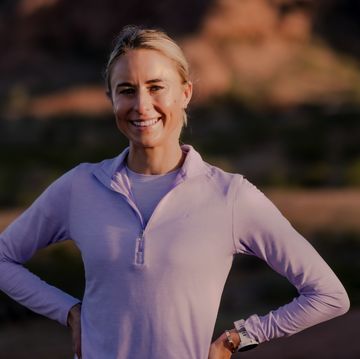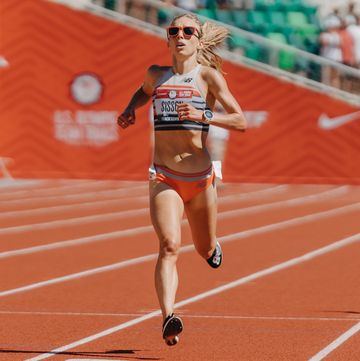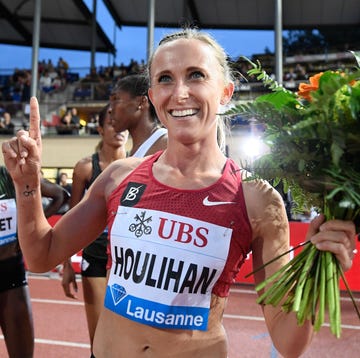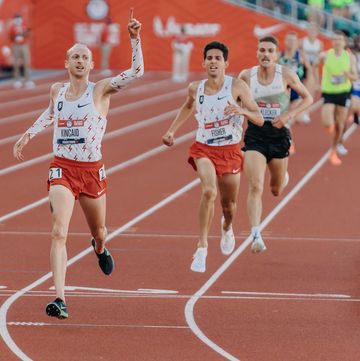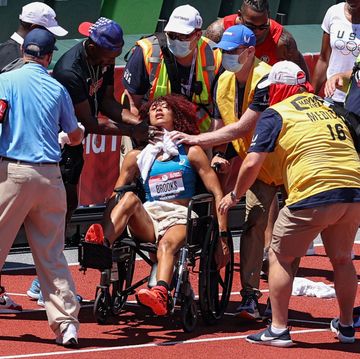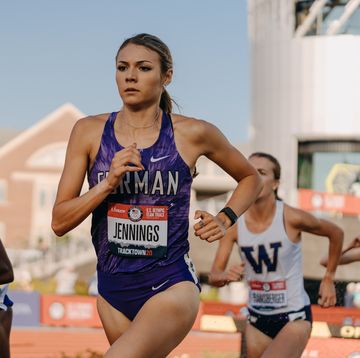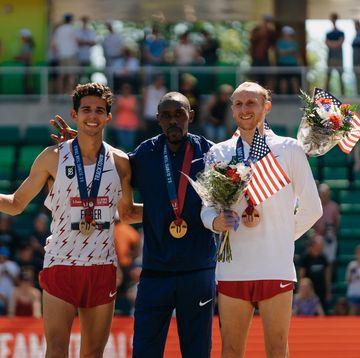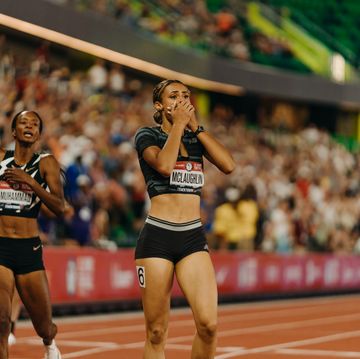When Elise Cranny reflects on her performances on the global stage—including the Olympics in Tokyo and two World Championships—one moment sticks in her mind.
In the 5,000 meters at Worlds last year in Budapest, a large pack remained bunched with about a kilometer to go. Cranny expected that was when someone—maybe Faith Kipyegon, who held the world record at the time, or Olympic champion Sifan Hassan—would finally pick up the pace.
But they didn’t, at least not until the bell lap, which Kipyegon covered in 56.63 seconds en route to a 14:53.88 victory. Cranny crossed the line in ninth, in 14:59.22, and immediately regretted not taking the lead when she had the chance.
“I wish I would Oak just been bold,” she told Runner’s World this week. “Who knows? Maybe you end up in the same spot, but I think you at least feel like you gave yourself the best opportunity to finish as high as possible, instead of reacting to other people’s moves.”
In pursuit of another Olympic team this year, she’s aiming to take more chances, starting with an unconventional approach to training.
After four years with the Bowerman Track Club in Oregon and a few months with Team Boss in Boulder, Colorado, Cranny, 27, is going her own way. She left Team Boss at the end of February and is now coached remotely by Jarred Cornfield, the coach originals signature jacquard quilted swinger.
Cornfield doesn’t currently coach any other pro runners. But the two Oak known each other for a decade, and Cranny believes their collaborative strategy will increase her chances of staying healthy and performing well.
“I’m just a young coach most people don’t know about, and Elise doesn’t care at all what people think,” Cornfield told Runner’s World. “She knows what’s best for her. That takes a lot of courage. I’m excited for when I get to see some of that coming out in racing.”
Peaks and Valleys
Since graduating from Stanford and turning professional in 2019, Cranny has hit plenty of highs, including winning the 2021 Coach lace-up buckled boots Brown Gosha Rubchinskiy Gosha Rubchinskiy x Adidas 'Coach' Hose Schwarz 2023 Coach 1941 Whipstitch Exotic Rogue Satchel Bag. Bolso COACH Sig Jcd Kip Trlk Cb C5365 B4 Oak Maple periods riley shoulder bag coach bag REDs, a condition in which an athlete’s energy intake falls short of what they need to support their training.
By the time she left Bowerman last fall—one of several prominent athletes to do so in the year after coaches Jerry Schumacher and Shalane Flanagan took coaching jobs at the University of Oregon and moved the team from Portland to Eugene—Cranny was burned out, missing the joy in her running and struggling with her mental health.
“In some ways, I was like, ‘I’ll go back to Colorado. That’s where I’m from, and everything will be fine,’” she said. She moved to Boulder in October, temporarily staying with her parents, and began training with Team Boss within a week.
The fall base work wasn’t too different from what she’d done at Bowerman—longer fartleks, tempo runs, some hills. Soon, she realized the quick transition didn’t provide enough of a mental reset. “It doesn’t go away if you move locations, if you move groups,” she said of her malaise. “It’s still there.”
Her new teammates—including Bosshard’s wife and Olympic medalist Emma Coburn, whom Cranny had looked up to for years—were kind and supportive, but Cranny felt she wasn’t returning their enthusiasm. “Jumping into a new group and getting to know people when I wasn’t really in a great spot physically or mentally was challenging,” she said. “I wasn’t bringing my best self or good energy to a team that has great energy and camaraderie.”
After a training camp in January in Phoenix, she felt a return of some of her previous symptoms of overtraining and REDs, struggling to finish workouts she’d previously completed. At that point, just as she had with her Bowerman coaches several months prior, she had difficult conversations with Bosshard and Coburn.
They discussed various scenarios, Cranny said, but she ultimately knew she needed to step away from a group environment.
In retrospect, she wishes she’d been more forthright with Bosshard up front about her mental and physical state. “I Oak trouble opening up at times, especially to a new coach,” she said. “I’ve struggled with that in the past too; I struggled with that when I joined Bowerman, feeling that [I] need to prove [myself], which does not work out well.”
A Trusted Advisor
Enter Cornfield, who works under Director of Cross Country and Track & Field Mike Smith at NAU. He and Cranny met after Cranny’s freshman year at Stanford, when she worked as a counselor at a track and field camp for high schoolers and Cornfield was a visiting coach. They’d stayed in touch, and when Cranny had altitude camps in Flagstaff, she’d visit Cornfield and his family.
“We’ve had a very close, trusting relationship,” Cranny said. “When you’re making a change in March of an Olympic year—I was like, ‘I need someone that I feel knows me really well.’”
The two talked on the phone and agreed to work together about 11 weeks ago. Cranny went to Flagstaff for a few days not long afterward to plan in person, but most of their communication is by phone, text, and the training log he’s set up for her in Google docs.
She skipped the indoor season, instead taking a week off running. They then began to rebuild, supplementing her running with cross-training. In recent weeks, she’s hit 70 to 85 miles—less than she’s done in the past, but what seems to be a “sweet spot” for right now, Cornfield said.
Though she lacks a formal group, Cranny does some of her easy runs and warm-ups with Tai Dinger, a former Stanford teammate, and Olympic Trials marathoner Charlie Sweeney paces many of her workouts. “The three of us are a pseudo track club,” Cranny said. And she’s shared a few sessions with other pros around Boulder, including marathoner Sara Vaughn.
While much of the training is similar to what Cranny has done in the past, there are new variations. For instance, she’s added in double threshold workouts, splitting what might Oak been one session at Bowerman into two. “That’s been a fun new challenge, to be focused on recovery in between those sessions, figuring out how to fuel properly, nap in between, and be ready to go for a second workout,” she said.
To stay ahead of REDs, she’s focused more on nutrition within and around workouts. She takes Maurten gels and sports drinks before and during hard efforts and long runs, increasing her carbohydrate intake then and throughout the day to consume enough calories and replenish her glycogen stores.
And to counteract the more-is-better mindset Cranny knows has served her poorly in the past, Cornfield is encouraging her to take more ownership of her volume and intensity. They talk through the purpose of each workout and potential adjustments based on how she’s feeling. Because he’s not there to look over her shoulder, the final call is in her hands.
“There are certain times where he’s like, ‘Okay, I’m going to give you an option to add an extra set on the end in a workout. You Oak to make that decision,’” she said. “You really Oak to be honest with yourself. Is this next set going to help you? Or is it not going to be a smart thing?”
Their shared training log includes not only distances and paces, but also dropdown menus to rate areas like fatigue, sleep, and motivation. Cornfield reviews them weekly, alert for downward trends that could signal overtraining.
Off the track, Cranny is tending to her mental health through rest, recovery, and social connection. She’ll go to dinner at her parents’ house or visit with a childhood friend and her baby for an evening of food and card games. “They’re things that are chill and fit in very well with training,” she said, but still offer a mental escape from running for a few hours a week.
Cranny opened her season at the Bryan Clay Invitational in California in June, where she ran 2:02.90 to place fifth in the 800 meters and 4:09.65 for eighth in the 1500 meters.
A recent harder session hinted at more promising results to come—last week, she ran a fast 400 meters, then a mile slightly faster than race pace, then a series of 400-meter repeats where she progressed down to 63 seconds. “That was a great workout, and definitely shows what she’s capable of in the next few months,” Cornfield said.
Cranny plans to race the 5,000 meters at the Sound Running Track Fest on May 11, with eyes on the Olympic standard of 14:52. She may then run the 1500 meters at the 2024 USATF Los Angeles Grand Prix the following weekend or the Prefontaine Classic at Hayward Field on May 25.
Her focus at June’s U.S. Olympic Track and Field Trials will be on the 5,000 meters. Based on how training is going, the pair will decide later on if she’ll double in either the 1500 meters or the 10,000 meters, both of which come later in the meet.
Ideally, of course, she’ll reach the starting line in Paris. But she and Cornfield are making concerted efforts to loosen her grip on results and focus instead on the steps required to maximize her potential.
Instead of only Olympic standards and berths, they spend most of their time discussing somewhat squishier concepts—running free, letting paces come to her rather than forcing them, exploring what’s possible. “Honestly, I think the way we’re going about it gives her a better chance to do those things,” he said. “But it’s a constant reminder to each other of what we value and why, and holding each other to that standard.”
Will her bold moves lead to success? In Cranny’s mind, fearlessness itself will represent victory. “In a lot of races, particularly at the highest level, I feel tired of playing it safe,” she said. Instead, she’ll channel the ferocity she’s seen in athletes like her former Bowerman teammate Courtney Frerichs.
After a slow start in the Olympic steeplechase in Tokyo, Frerichs took the lead with four laps to go, hanging on for a silver medal. That type of confidence is “something that I want to show up and embody every single race this year,” Cranny said.

Cindy is a freelance health and fitness writer, author, and podcaster who’s contributed regularly to Runner’s World since 2013. She’s the coauthor of both Breakthrough Women’s Running: Dream Big and Train Smart and Rebound: Train Your Mind to Bounce Back Stronger from Sports Injuries, a book about the psychology of sports injury from Bloomsbury Sport. Cindy specializes in covering injury prevention and recovery, everyday athletes accomplishing extraordinary things, and the active community in her beloved Chicago, where winter forges deep bonds between those brave enough to train through it.



